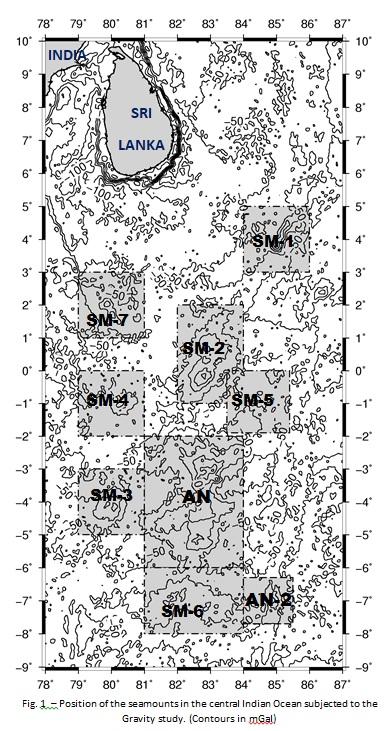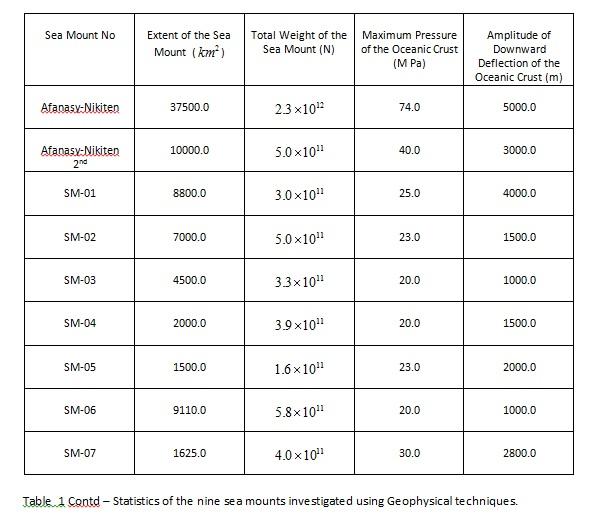Interpretation of Gravity Anomalies over the Afanasy-Nikiten and Other Seamounts in the Central Indian Ocean (2017)
Dr. M. M. P. M. Fernando and Prof. D. A. Tantrigoda
Abstract
Free air gravity anomalies over nine sea mounts in the Central Indian Ocean below Sri Lanka including Afanasi-Nikiten sea mount have been interpreted three dimensionally and the bending of the Oceanic Crust due to the pressure exerted by the sea mounts has been calculated. Bending of the Oceanic Crust below the sea mounts were also calculated using the elastic properties of the Oceanic Crust and found that the results agree with those of the gravity interpretation. Several important statistics including the bending of the oceanic crust due to the sea mounts and the role played by the sea mounts in the pressure distribution of sediments below Sri Lanka otherwise would have taken the shapes of smooth wedge turning towards the south have been presented.
Introduction
This paper mainly presents a detailed three-dimensional interpretation of satellite gravity anomalies over the Afanasy-Nikiten seamount in the central Indian Ocean and another seamount situated close to it in the southeastern direction. Gravity anomalies over seven more relatively smaller seamounts have been also interpreted and discussed in this paper. Computer program written by using Cordell and Henderson (1968) technique has been used in the interpretation. Main purpose of the interpretation is to estimate the downward deflection of the oceanic crust due to pressure exerted by the seamounts and also to determine the sediment thickness around the seamounts. Being a detailed three-dimensional interpretation, results produced in this study are more accurate than previous two dimensional interpretations (Tantrigoda, 2013).
Downward migration of the oceanic crust due to the pressure exerted by weight of the volcanic rocks of seamounts have been calculated considering the oceanic crust as a thin plate of infinite extent lying on the upper mantle which is considered as a visco-elastic fluid. 
Discussion
Satellite gravity anomalies over the Afanasi-Nikiten chain of sea-mounts and seven more relatively smaller seamounts in the central Indian Ocean have been interpreted in three dimension using the Cordell and Henderson (1968) technique and downward migration of the bottom surface of the oceanic crust has been calculated. According to the results of the interpretation bending of oceanic crust varies from 5 km to 1 km below the different seamounts. This parameter was also calculated using elastic properties of the oceanic crust approximating the oceanic crust to a very large thin plate lying on a viscoelastic fluid. It was also assumed that the region under investigation is in isostatic equilibrium. This study produced results approximately equal to that of the gravity interpretation indicating the region is in isostatic equilibrium. (This is an assumption used in determination of the downward migration)
In the calculation of bending of the oceanic crust using its elastic properties, it is necessary to know the flexural rigidity of oceanic crust. A value of 1.8 x 1021 Nm was used for this parameter following Liu et al. (1982). It was found even doubling of flexural rigidity does not affect the calculated value of downward migration of oceanic crust. Therefore slight discrepancy between the actual value of flexural rigidity of oceanic crust of the region and value used in the calculation does not affect the results of the calculation very much.
Seamounts have been emplaced as a result of igneous intrusions. Total area that is being covered by seamounts and 85oE ridge is almost 3.6 x 105 km2. Emplacing of volcanic rocks over such a large area may even lead to the buckling of oceanic crust. Buckling of oceanic crust in the central Indian Ocean that can be observed today may be partly due to this phenomenon.
Results



